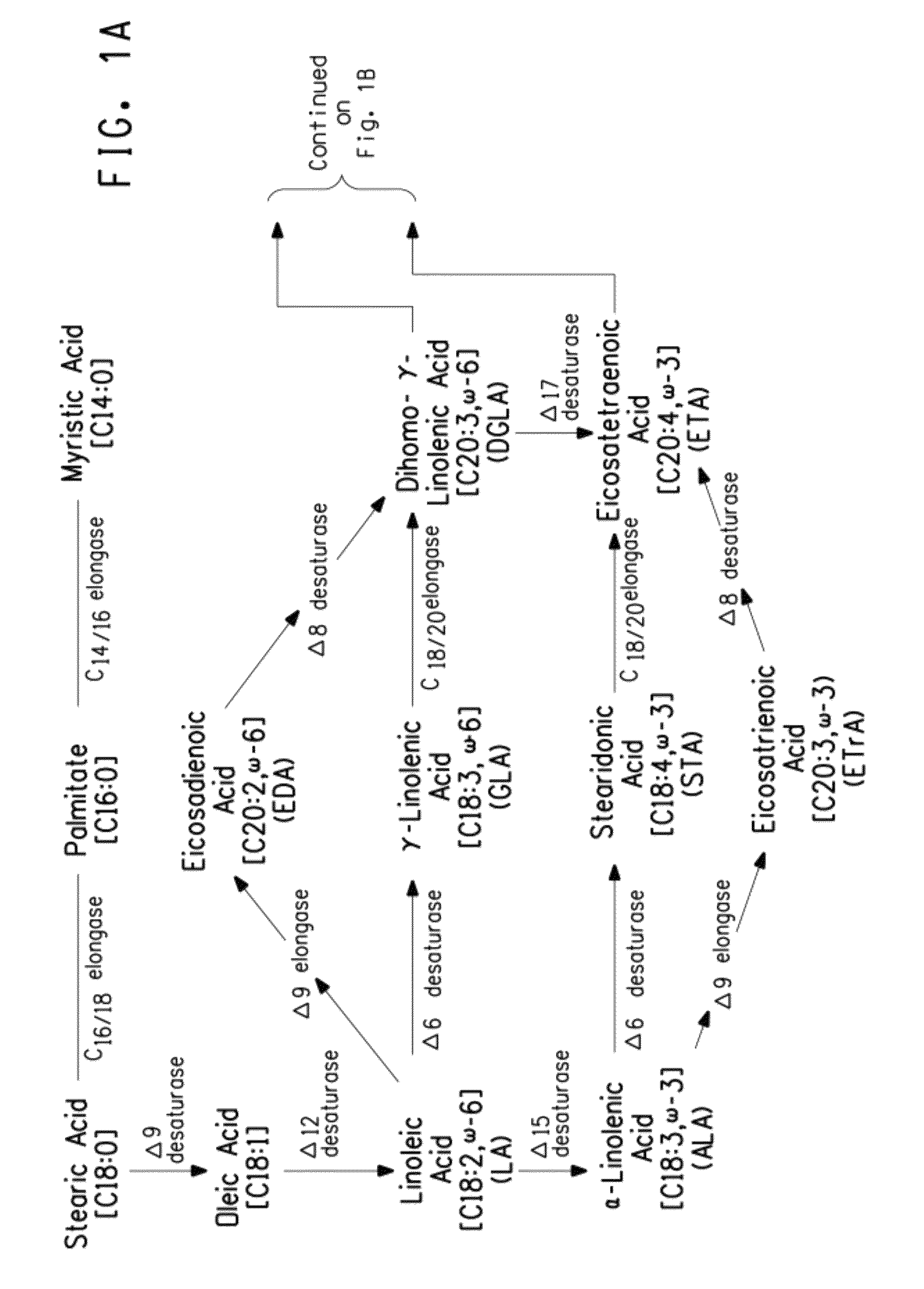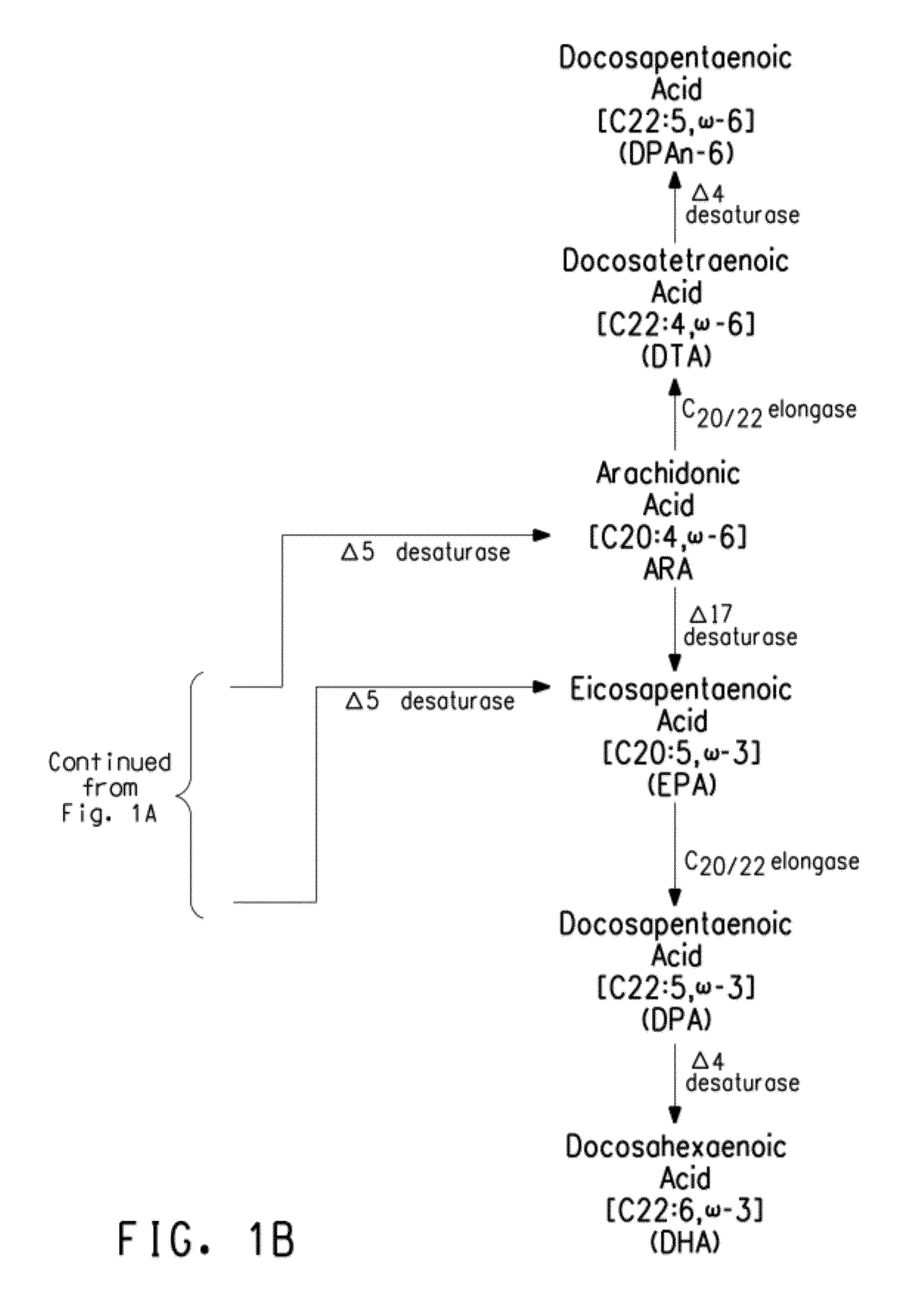Mutant Δ5 desaturases mutated in the heme-binding motif (HPGG) and their use in making polyunsaturated fatty acids
a technology of desaturases and 5 fatty acids, applied in the field of biotechnology, can solve problems such as reducing enzyme activity
- Summary
- Abstract
- Description
- Claims
- Application Information
AI Technical Summary
Benefits of technology
Problems solved by technology
Method used
Image
Examples
example 1
Construct pDMW369, Comprising EgD5S
[0198]The present Example describes plasmid pDMW369, comprising a chimeric FBAIN::EgD5S::Pex20 gene (plasmid construction is described in Intl. App. Pub. No. WO 2007 / 136671). Plasmid pDMW369 (FIG. 2A; SEQ ID NO:19) contained the following components:
[0199]
TABLE 7Components Of Plasmid pDMW369 (SEQ ID NO: 19)RE Sites AndNucleotidesWithin SEQ IDDescription Of Fragment AndNO: 19Chimeric Gene ComponentsEcoR I / BsiW IFBAIN::EgD5S::Pex20, comprising:(6063-318)FBAIN: Yarrowia lipolytica FBAIN promoter (U.S.Pat. No. 7,202,356)EgD5S: codon-optimized Δ5 desaturase (SEQ IDNO: 9), derived from Euglena gracilisPex20: Pex20 terminator sequence of YarrowiaPex20 gene (GenBank Accession No. AF054613)1354-474ColE1 plasmid origin of replication2284-1424ampicillin-resistance gene (AmpR) for selectionin E. coli3183-4476Yarrowia autonomous replication sequence(ARS18; GenBank Accession No. A17608)6020-4533Yarrowia Ura 3 gene (GenBank Accession No.AJ306421)
example 2
Identification Of HXGG Mutations that Result in Improved Δ5 Desaturase Activity in EgD5S
[0200]Single amino acid mutations were carried out using pDMW369 (Example 1) as the template and 19 pairs of oligonucleotides (SEQ ID NOs:20-57; Table 8) as primers to individually mutate the proline residue of the HPGG motif of EgD5S (SEQ ID NO:10) by site-directed mutagenesis (QuickChange Kit, Stratagene, Calif.), thereby generating all amino acid substitutions possible (i.e., His-Xaa-Gly-Gly [HXGG] mutants, wherein Xaa can be any amino acid). Plasmids comprising each mutation were transformed into E. coli XL2Blue cells (Stratagene). Four colonies from each of the 19 transformations were picked and grown individually in liquid media at 37° C. overnight. Plasmids (i.e., 76 total) were isolated from these cultures and sequenced individually to confirm the mutations.
[0201]The wild type pDMW369 plasmid and the isolated mutant plasmids were transformed into strain Y4036U individually, as described i...
example 3
Identification of HPGX Mutations that Result in Improved Δ5 Desaturase Activity in EgD5S
[0205]Single amino acid mutations were carried out using pDMW369 (Example 1) as the template and 19 pairs of oligonucleotides (SEQ ID NOs:59 to 96; Table 9) as primers to individually mutate the second glycine residue of the HPGG motif of EgD5S (SEQ ID NO:10) by site-directed mutagenesis (QuickChange Kit, Stratagene, Calif.), thereby generating all amino acid substitutions possible (i.e., His-Pro-Gly-Xaa [HPGX] mutants). Following mutagenesis, plasmids were transformed into Y4036U, transformants were selected and grown in MMLeu and HGM, and FAMEs were prepared and analyzed by GC, as described in Example 2.
[0206]The Δ5 desaturase activity attributed to each mutation within the HPGG motif is summarized below in Table 9. EgD5S mutants are designated according to the sequence of the mutant HPGX motif (i.e., the HPGG motif in mutant EgD5S-HPGA had a G4 to A substitution, thereby yielding a His-Pro-Gly...
PUM
| Property | Measurement | Unit |
|---|---|---|
| temperature | aaaaa | aaaaa |
| temperature | aaaaa | aaaaa |
| temperature | aaaaa | aaaaa |
Abstract
Description
Claims
Application Information
 Login to View More
Login to View More - R&D
- Intellectual Property
- Life Sciences
- Materials
- Tech Scout
- Unparalleled Data Quality
- Higher Quality Content
- 60% Fewer Hallucinations
Browse by: Latest US Patents, China's latest patents, Technical Efficacy Thesaurus, Application Domain, Technology Topic, Popular Technical Reports.
© 2025 PatSnap. All rights reserved.Legal|Privacy policy|Modern Slavery Act Transparency Statement|Sitemap|About US| Contact US: help@patsnap.com



